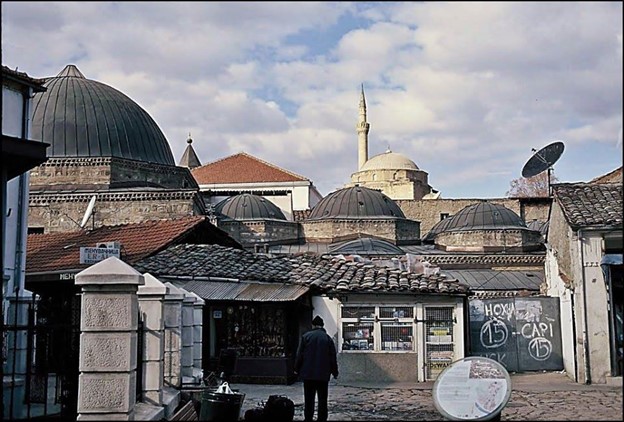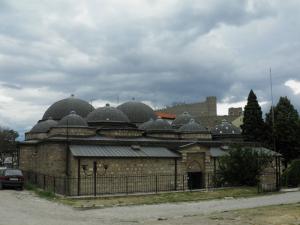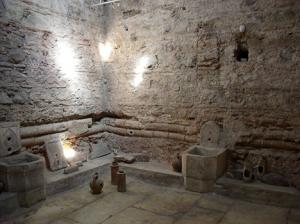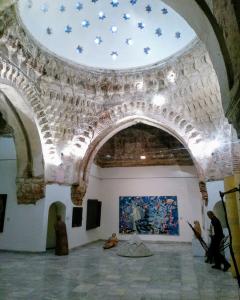Researchers Highlight the Turkish Hammam’s Role in Muslim Ritual and Community Life

Built in 15th Century by Isa Bey, this hammam is located in the middle of the Old Skopje Bazaar, between the Murat Pasha Mosque and the Suli Lodging. Alongside these two buildings, they remain the only "Islamic trio" in the area of the bazaar and in Skopj

External view of the building and the entrance to the hammam of Daut Pasha in Skopje. Credit: Dr. Eyüp Kul

One of the rooms in the Shifte Hammam in Skopje, the only one that has not been turned into a gallery, along with its auxiliary rooms. Credit: File:Čifte hamam u Skoplju.JPG - Wikimedia Commons
A recent study highlights the pivotal role of the Turkish hammam in preserving Islamic traditions and adapting to diverse local cultures of Muslim communities.
SHARJAH, EMIRATE OF SHARJAH, UNITED ARAB EMIRATES, September 1, 2025 /EINPresswire.com/ -- The Turkish hammam is far more than a place for physical cleansing—it is a deeply rooted institution in the public and religious life of Muslim societies.
Unlike the ancient Graeco-Roman thermae, which primarily served as venues for bathing and relaxation, Turkish public baths, or hammams, have historically functioned as spiritual and communal centers in the Muslim world.
In a recent article, Prof. Mesut Idriz, Professor of Islamic History and Civilization at the University of Sharjah and Director of the Sharjah International Foundation for the History of Muslim and Arab Sciences (SIFHAMS), explores the historical and cultural significance of the hammam. He traces its evolution across Muslim societies and highlights its multifaceted role. (Original Source URL: https://alongthesilkroad.com/2025/07/17/the-history-of-the-hammam/?fbclid=IwQ0xDSwLmPDhleHRuA2FlbQIxMQABHiJTqgjO93uS8XpS4eCKr7-yhFwFZAo_zsKm_2AaDOI3A2JvNz4zr2jE4hY2_aem_kysrGdcTptvi63t279ESXg)
“The terms thermae (Graeco-Roman) and hammam (Arabic and Islamic) both refer to steam baths or places that spread warmth,” writes Prof. Idriz. However, he emphasizes that the hammam in Muslim societies held a religious function, often used for rituals requiring full-body purification with clean water—rituals performed by both the living and for the deceased.
Prof. Idriz links hammam bathing to the Islamic practice of ghusl, the major ablution required after events such as sexual intercourse, seminal emission, menstruation, or childbirth. “Ghusl must be performed whenever a state of major ritual impurity has been incurred,” he explains.
Integrated into the urban planning of Islamic cities, hammams were not only public bathing facilities but also cultural landmarks. While inspired by Roman thermae, Muslims across regions invested heavily in their construction, and many surviving hammams are preserved as architectural marvels of the Ottoman era.
Though sharing similarities with Roman and European bathhouses, the hammam developed distinct practices grounded in Islamic principles.
Prof. Idriz notes that the Quran’s emphasis on water as the source of life elevated the hammam’s spiritual significance in Islam. Rituals such as wudu (ablution) and ghusl institutionalized the hammam as a communal space accessible to all social classes.
“The hammam tradition is rooted in Islam’s emphasis on cleanliness and the sacredness of water,” he writes. “Throughout Muslim history, it enabled people to maintain both physical cleanliness and spiritual readiness.”
Prof. Ebru Ibish, Professor of Legal Studies at the International Balkan University in Skopje, North Macedonia, echoes this sentiment. She connects the hammam tradition to Islam’s focus on purification of both body and soul.
“Cleanliness, attention to personal hygiene, and spiritual purification are deeply embedded in Islamic teachings and daily practice,” she says. “It is only natural that the hammam, a place dedicated to cleansing, is strongly associated with these core values.”
A widely cited saying among Muslims, “Cleanliness is half of faith”, underscores the hammam’s religious importance. Prof. Ibish explains that the hammam historically served as a vital institution for fulfilling this aspect of faith, making it a cornerstone of religious observance and community life.
“Visiting the hammam is more than a social or hygienic custom,” she adds. “It reflects Islam’s continuous reminder that maintaining purity is a duty for both the physical body and the spiritual self. The hammam bridges inner and outer cleanliness.”
Dr. Eyup Kul, Associate Professor of Ottoman History at Recep Tayyip Erdoğan University, explains that hammams during the Ottoman era were considered essential public utilities. They were often constructed to serve the needs of religious and educational institutions such as mosques, madrasas, zawiyas, and tekkes, he points out.
“For the Ottomans, constructing a hammam in a city was as essential as founding a school,” emphasizes Dr. Kul. “This is why public baths were established throughout the territories they conquered beyond the borders of present-day Turkey.”
Dr. Kul further notes that hammams were significant sources of revenue for waqfs (religious endowments) that supported urban infrastructure and social services. “Although many have been demolished or now lie in ruins,” he adds, “it is still possible to find hammams built during the Ottoman period.”
Though not originally an Islamic invention, public bathhouses became widespread in the early Islamic period, spreading from the Middle East and North Africa to the Balkans and Spain. In each region, the hammam adapted to local cultures and norms, always maintaining gender separation.
While influenced by Roman baths, the Muslim hammam evolved uniquely within Islamic culture. Prof. Idriz notes that they became symbols of Ottoman tradition, offering massage, heat, and water for both physical and spiritual healing.
“Historically, the hammam symbolized a clean body and a clean society,” he writes. “It promoted health, hospitality, and moral behavior. Public officials regularly inspected hammams to ensure hygiene and order. Entrance fees were kept low so that everyone—rich or poor—could access them.”
Prof. Idriz hopes his research will inspire greater interest in the hammam tradition across industries, cultural institutions, and academia.
“While grounded in historical and cultural analysis, the findings have relevance beyond academia,” he says. “They offer insights for wellness tourism, heritage preservation, and architectural restoration.”
By highlighting the hammam as a multifaceted institution—combining hygiene, spirituality, and community—the study encourages cross-sector collaboration to revive and adapt this heritage for contemporary audiences.
Prof. Idriz believes that exploring the social and spiritual dimensions of the hammam has practical applications in cultural heritage preservation, tourism, urban planning, and intercultural education.
At the height of the Ottoman Empire in the 16th century, Istanbul alone boasted around 230 hammams; today, only about 60 remain in operation.
Looking ahead, Prof. Idriz and his colleagues plan to investigate how the hammam tradition evolved across regions such as the Middle East, the Balkans, North Africa, and Andalusia, shedding light on local cultural and religious adaptations.
LEON BARKHO
University Of Sharjah
+971 50 165 4376
email us here
Legal Disclaimer:
EIN Presswire provides this news content "as is" without warranty of any kind. We do not accept any responsibility or liability for the accuracy, content, images, videos, licenses, completeness, legality, or reliability of the information contained in this article. If you have any complaints or copyright issues related to this article, kindly contact the author above.


